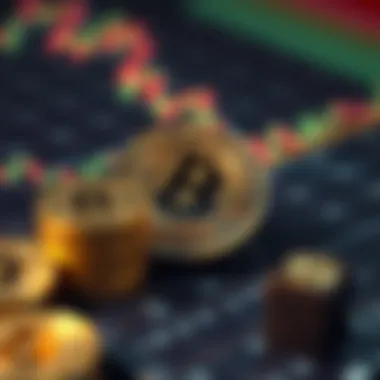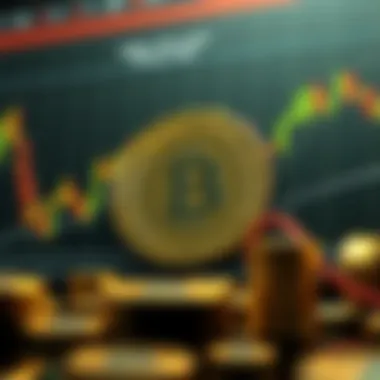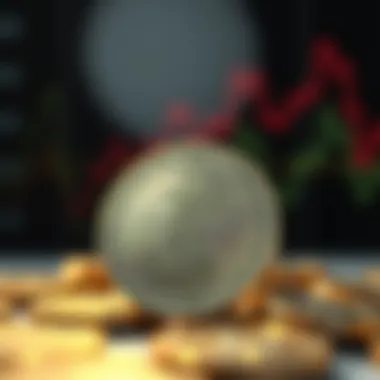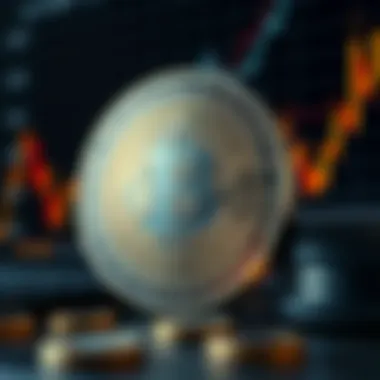Ruble Chart Analysis: Trends and Future Outlook


Intro
The ruble, Russia's official currency, has seen its fair share of highs and lows over the years, influenced by a multitude of factors ranging from geopolitical tensions to shifts in global trade. Understanding the dynamics that govern the ruble is particularly vital for investors and cryptocurrency enthusiasts, as the information can shed light on broader market trends and investment opportunities. The interplay of external and internal forces creates a complex landscape for the ruble, making detailed analysis essential for anyone looking to navigate its fluctuations and the implications tied to them.
Turkey’s lira might capture headlines for its volatility, but the ruble offers its own compelling narrative, shaped largely by Russia's unique economic and political position. With Russia’s energy exports playing a major role in rubbing alongside world markets, how the ruble fares in comparison to major currencies often reflects deeper economic conditions, making it an essential topic for investors looking toward alternatives like cryptocurrency.
By diving into the ruble chart, one can glean insights not only about currency fluctuations but the implications those changes hold for the global financial landscape. For example, are investors more likely to convert rubles into Bitcoin as the ruble weakens? What business opportunities emerge when the ruble is strong? These questions highlight the relevance of an informed analysis, paving the way for smarter decisions in a world of intertwined currencies.
In this piece, we will explore the nuances of the ruble chart, looking at historical patterns, current trends, and future forecasts. This journey will help piece together the larger puzzle, providing context that is crucial for anyone invested in the world of cryptocurrencies and beyond. Together, let’s navigate through the intricate connections between traditional currencies and the digital frontier.
Prolusion to the Ruble Chart
The ruble chart serves as a key tool in understanding the fluctuations of the Russian currency in a complex global market. By analyzing the ruble's value against major currencies, one can glean insights into economic conditions, geopolitical dynamics, and market sentiments. For investors, traders, and analysts, these charts provide a visual representation of trends and movements that can significantly influence investment strategies.
Understanding the ruble chart not only aids in making predictions about future trends but also helps in assessing the overall health of the Russian economy. For instance, when the ruble weakens against the US dollar or euro, it could signal underlying economic issues or changing political landscapes.
Definition of the Ruble Chart
A ruble chart is essentially a graphical representation of the ruble's value over time against other currencies. It tracks movements in exchange rates, showing buyers' and sellers' sentiments. Various factors can influence these movements, from political instability to changes in commodity prices, as Russia is a significant player in global energy markets.
Typically, these charts display daily, weekly, or monthly data. Traders often use them to identify patterns and trends that might not be immediately obvious in raw data. For instance, a rising trend might suggest increasing confidence in the Russian economy, while a sudden dip could indicate a looming crisis.
Importance of Currency Charts
Currency charts hold vital importance for several reasons:
- Market Analysis: They provide a straightforward way to analyze trends and make informed decisions regarding investments.
- Visual Tools: Charts simplify complex data, making it easier for investors to interpret market behaviors.
- Predictive Insights: Patterns identified through these charts can help forecast potential future movements in currency values.
- Decision Making: For traders, timely decisions are crucial. Understanding chart trends can improve timing for buy or sell actions.
"In the world of finance, knowledge is currency. A deep understanding of chart trends can be more valuable than gold itself."
Thus, a robust grasp of ruble charts can empower individuals to better navigate the choppy waters of the currency market. Currency charts are not just numbers and lines; they reflect real-world events and sentiments that can have significant implications for investments and economic assessments.
Historical Background of the Ruble
Understanding the historical background of the ruble is crucial in analyzing its current value and predicting its future trends. The evolution of the ruble paints a vivid picture not only of currency dynamics but also of the socio-economic conditions that surround it. By delving into notable historical events that influenced the ruble's performance, investors can glean significant insights into possible market movements and economic sentiment.
Evolution of the Ruble
The ruble has a long and eventful history that dates back centuries, making it one of the oldest currencies still in existence today. Initially, the ruble served as a unit of value based on the weight of silver or gold. This predominant characteristic facilitated trade and established trust among merchants. Over time, the ruble evolved through various political and economic phases, reflecting the shifting tides of Russian history.
During the 18th and 19th centuries, it underwent significant reforms. The introduction of banknotes by the State Bank of Russia in the 1860s represented a turning point, as it laid the groundwork for modern currency systems in the country. However, this evolution was not without its challenges, particularly during periods of war and revolution, where inflation and devaluation became rampant.
Major Historical Events Impacting the Ruble
Critical historical events have left a deep mark on the ruble, shaping its value against other currencies. These events provide context for the current performance of the ruble and underline key lessons for investors.
Post-Soviet Transition
The transition from a centrally planned economy to a market-oriented system post-1991 holds substantial ramifications for the ruble. As the Soviet Union disintegrated, the abrupt economic reforms led to hyperinflation—a consequence of implementing shock therapy without necessary safety nets. This period saw the ruble's value plummet, rendering it almost worthless, which caused tremendous hardship for citizens. Understanding this tumultuous shift helps grasp the resilience and struggles of the ruble in subsequent decades, affecting trust in the currency and foreign investment.
- Key Characteristic: Hyperinflation; significant loss of value.
- Impact: Fostered distrust and instability, complicating recovery efforts.
- Unique Feature: Showcases a classic example of currency destabilization in the wake of systemic change.
Financial Crisis
The 1998 financial crisis marks another pivotal moment in the ruble's journey. Triggered by a mix of economic mismanagement, falling oil prices, and a lack of liquidity, Russia defaulted on its domestic debt, leading to a devaluation of the ruble. This event underscored the currency's vulnerability to external shocks and economic fundamentals.
- Key Characteristic: Default on government debt; a confident signal of instability.
- Impact: Major capital flight and widespread economic despair.
- Unique Feature: The crisis pushed reforms and led to the eventual stabilization and resurgence of the ruble post-2000, becoming a learning moment for policymakers.
Global Economic Recession
The global economic recession of 2008 further exposed the ruble to external pressures. Russia's economy, heavily reliant on oil exports, felt the brunt of declining prices and demand, catalyzing a marked depreciation in the currency value. Moreover, geopolitical tensions during this period exacerbated the situation, stifling growth and leading to further depreciation in the ruble.
- Key Characteristic: Declining oil prices; reveals interdependencies.
- Impact: Economic contraction and increased inflation, affecting consumers.
- Unique Feature: Highlighted the ruble's sensitivity to global markets and external geopolitical tensions, providing a cautionary tale for investors to monitor broader economic landscapes.
Current Trends in the Ruble Value
Understanding current trends in the ruble's value is vital for anyone keeping an eye on economic movements, especially in the context of global trade and crypto markets. The ruble does not exist in a vacuum; it reflects a mix of local economic policies, global commodity prices, and geopolitical realities. Investors and analysts benefit from exploring these trends as they can inform better financial decisions and strategies. Wage fluctuations, trade balances, and even oil prices can influence the currency's direction, creating a complex tapestry where every thread plays a part. By staying abreast of these trends, investors can anticipate potential capital shifts that may favor or hinder their positions.
Recent Performance Analysis


Recent performance of the ruble illustrates its sensitivity to both domestic policies and international developments. In the short term, the ruble has experienced fluctuations due to varying factors. For instance, as oil prices spiked, the ruble appreciated significantly, indicating the strong correlation between Russian oil exports and currency value. Conversely, recent sanctions and political uncertainty have sparked volatility that can catch even seasoned investors off guard. Analyzing daily, weekly, and monthly trends provides a clearer picture of where the ruble may be heading in the near future.
Here's a closer look at some recent metrics:
- Oil Prices: When oil prices surged, the ruble generally strengthened.
- Inflation Rates: Recent spikes in inflation had a negative impact, causing the ruble to weaken against major currencies.
- Economic Reports: Quarterly results have shown mixed signals for the economy, making it crucial to stay updated with the latest reports and trends.
This analysis reflects that the ruble's journey is steeped in broader economic currents, where external factors can drastically shift investor sentiment in a matter of days.
Market Sentiment and the Ruble
Market sentiment significantly sways the ruble's value. Investors' perceptions can often trump hard data, resulting in movements that might seem irrational in hindsight but make sense in the climate of fear or optimism. Factors such as geopolitical events, policy changes, and economic forecasts shape this sentiment.
For example, news of potential lifting of sanctions often leads to bullish behavior among traders, as they anticipate economic recovery and growth potential. On the flip side, negative sentiments, whether based on geopolitical tensions or dire economic reports, can prompt panic selling.
"Market sentiment is a fickle friend; it can build you up or tear you down faster than you think."
Some critical indicators to keep in mind include:
- News Events: Geopolitical shifts can alter market sentiment literally overnight.
- Trends in Cryptocurrency: Fluctuations in crypto markets may strangely echo back to traditional currencies like the ruble.
- Trade Agreement Discussions: Any dialogue on trade partnerships can either inspire hope or dread, instantly impacting sentiments.
These factors, interwoven with psychological elements, highlight the need for investors to remain vigilant and adaptable. Staying in tune with market sentiment can offer insight into where the ruble might be heading, allowing for a more informed approach to investments.
Factors Influencing the Ruble
Understanding the factors influencing the ruble is imperative for anyone interested in currency trading or investing. It’s not just about numbers on a chart; it’s about the broader economic and geopolitical context that shapes those numbers. Different elements play distinct roles in determining the ruble's strength or weakness against major currencies. In this section, we’ll dissect both economic indicators and geopolitical considerations, laying out how each factor can potentially sway the ruble's value.
Economic Indicators
Inflation Rates
Inflation rates serve as a critical barometer for any economy, and Russia is no exception. When inflation is high, the purchasing power of the ruble diminishes. Thus, tracking inflation can provide insights into the health of the economy. A consistent rise in inflation can result in increased interest rates as central banks look to calm spiraling prices. One key characteristic of inflation data is its immediacy; figures are often released monthly, giving traders timely information. However, inflation can also be deceptive. It is sometimes influenced by external factors like energy prices that Russia heavily relies on. An advantage of monitoring inflation rates lies in their ability to predict shifts in monetary policy. Conversely, high inflation can erode investor confidence, potentially leading to a decrease in ruble valuation.
Interest Rates
Interest rates are another focal point, fundamentally tied to both inflation and overall economic activity. The Central Bank of Russia utilizes interest rates as a tool for controlling inflation—raising them when inflation is deemed too high and lowering them to stimulate spending during downturns. A unique feature of interest rates is their dual impact on the economy: lower rates may spur growth but could also signal economic weakness, while higher rates might strengthen the ruble in the short run but also stifle growth. For this article, interest rates dignify their role as a leading indicator in forecasting market behavior, especially for those trading in foreign exchange markets.
GDP Growth
GDP growth reflects the overall economic performance and is a telltale sign of the economic health of a country. A robust GDP growth rate often correlates with a strong currency, as it suggests a thriving economy and increased consumer spending. The ruble, buoyed by high GDP growth rates, tends to attract foreign investment which can drive its value higher. What’s particularly interesting about GDP growth is that it is often reported quarterly, thus providing a periodic check-up on the economy. However, an overreliance on GDP stats can mislead traders, as growth spurred by volatile regions, such as commodities, may not be sustainable. It’s essential to consider broader economic context, making GDP a valuable, yet imperfect, measure of long-term ruble strength.
Geopolitical Considerations
Sanctions
Sanctions can dramatically affect the ruble, acting as a double-edged sword. They can severely limit economic growth by stymieing trade relations and limiting access to international markets. High-profile sanctions, whether imposed due to political missteps or conflicts, create uncertainty which traders often translate into currency weakness. It’s worth noting that the markets react not just to the sanctions themselves but also to the anticipation of new ones. An benefit of understanding sanction dynamics in this article is that those who grasp their implications can better navigate a market susceptible to sudden changes, potentially safeguarding their investments. However, one downside is the unpredictable nature of geopolitical events; a sudden escalation can render predictions moot.
Trade Relations
The state of Russia's trade relations has direct ramifications for the ruble. Strong trading partnerships, especially with major economies, usually bolster the currency’s standing. For instance, exports of oil and gas play a pivotal role in the economy and can balance trade deficits when relations are constructive. Conversely, strained relations, perhaps due to political tensions or trade wars, can hinder the flow of goods and lead to currency depreciation. A distinct feature of trade relations is their ability to shift rapidly; a signed trade deal can inflow positively, while tariffs imposed overnight can shift investor sentiment. For this article, trade relations represent a clear-cut, practical aspect that traders and investors can monitor regularly.
Political Stability
Political stability in Russia is crucial for maintaining investor confidence. A stable government tends to attract foreign investment, strengthening the ruble. However, political unrest, elections, or corruption scandals can lead to a swift decline in the ruble’s value—as investors seek safer havens during turbulent times. The key characteristic that makes political stability particularly noteworthy is its long-term impact; sudden shifts in governance or unrest can have prolonged implications. While stability is beneficial, overconfidence in a stable political climate might lead to complacency among investors, resulting in delayed reactions to emerging risks.
Understanding factors like inflation rates, interest rates, GDP growth, sanctions, trade relations, and political stability allows for a more nuanced approach to interpreting ruble trends.
Technical Analysis of the Ruble Chart
Technical analysis plays a crucial role in understanding the ruble chart. It provides investors with a lens to scrutinize price movements, helping to predict future behavior based on historical data. For those involved with currencies and cryptocurrencies, being versed in this analysis is akin to having a road map through a complex city—obtaining clarity in a chaotic financial environment.
Among the various tools and techniques available, understanding chart patterns provides foundational insights into trader behavior and market sentiment. When paired with assessments of indicators, traders can make informed decisions rather than acting purely on instinct or global news cycles.
Understanding Chart Patterns
Chart patterns are essentially the language of traders; they narrate stories of bullish trends and bear pitfalls. Recognizing these patterns can help identify potential price movements and market trends. Patterns such as head and shoulders, triangles, and double tops or bottoms are particularly important for understanding shifts in market momentum. These formations appear over and over again because they are based on trader psychology.
Let's break these down:
- Head and Shoulders: This pattern often signals a reversal in trend, which can be critical for traders looking to time their market entries and exits appropriately. When the pattern forms, it typically indicates that the market is preparing to shift from a bullish to a bearish phase.
- Triangles (Ascending/Descending): These patterns mark consolidation phases in the market. Recognizing them can help traders prepare for potential breakout scenarios, whether up or down, so they can position themselves favorably.
Chart patterns are pivotal in short-term trading but must be contextualized within broader market movements for effective utilization.


Key Indicators for Traders
Indicators serve as the backbone of technical analysis. These mathematical calculations provide insights into market trends and conditions, guiding traders in making decisions. Let's delve into three essential indicators used widely by traders:
Moving Averages
Moving Averages (MAs) smooth out price data by creating a constantly updated average price. The two common types are the Simple Moving Average (SMA) and the Exponential Moving Average (EMA).
- Key Characteristic: Moving averages are lagging indicators; they react to price movements rather than predict them.
- Benefits for this Article: MAs offer a simple way to gauge the trend direction. Whether the price is above or below the moving average can signal bullish or bearish market conditions.
- Unique Feature: The cross-over of two different moving averages can indicate a change in trend. For example, when a short-term MA crosses above a long-term MA, a bullish signal is generated, prompting potential buying actions from traders.
However, one should tread carefully as moving averages can lag in fast-moving markets, potentially leading to missed opportunities.
RSI Analysis
The Relative Strength Index (RSI) is another critical gauge of market momentum. It measures the speed and change of price movements and ranges from 0 to 100, indicating whether an asset is overbought or oversold.
- Key Characteristic: Traders often consider an RSI above 70 as overbought and below 30 as oversold. These conditions can prompt contrarian positions; for instance, buying when everyone else is panicking during a downturn.
- Advantages in this Article: The RSI helps traders hone their entry and exit points, optimizing timing and pricing strategies.
- Disadvantages: The RSI can produce false signals in volatile markets, which might lead to ill-timed trades.
Bollinger Bands
Bollinger Bands consist of a middle band (the moving average) and two outer bands that represent price volatility. The proximity of price action to these bands often indicates potential trading opportunities.
- Key Characteristic: The bands widen with increased volatility and squeeze during periods of low volatility, creating tension and hinting at potential breakouts.
- Benefits for this Article: Bollinger Bands offer traders insight into market conditions; prices moving towards the upper band signal a potential drop, while approaching the lower band indicates a possible rise.
- Unique feature: They adapt to market conditions, making them versatile across varying volatility levels. However, like other indicators, they can also produce misleading signals in the absence of context, meaning traders should complement them with other analyses.
In summary, a deep dive into the ruble chart through technical analysis arms investors with the insights needed to navigate forex waters intelligently. By mastering patterns and indicators, one can make well-positioned decisions, leading to informed trading strategies that align with market realities.
Comparative Analysis with Major Currencies
When it comes to understanding the ruble's positioning in the global economic landscape, a comparative analysis with major currencies is not just useful, it's essential. This perspective allows investors, analysts, and enthusiasts to gauge how the ruble stacks up against other currencies like the US dollar or the Euro. By examining these relationships, stakeholders can discern underlying trends, volatility, and potential opportunities or risks that could influence their investment strategies.
The currency market is often a reflection of broader economic conditions. Thus, evaluating the ruble against prominent currencies can provide insights into Russia's economic strength, investor confidence, and even geopolitical stability. Key elements of this study include:
- Relative Strength: Understanding how the ruble performs comparatively provides clarity on its value situation.
- Market Sentiment: Analyzing fluctuations in the ruble against major currencies may reflect market feelings towards Russian economic policies or global events.
- Investment Opportunities: Identifying when the ruble is undervalued or overvalued can lead to lucrative investments for those looking at currency trading.
In summary, comparing the ruble with major currencies offers a lens into its performance, helping investors craft tailored strategies while underscoring the importance of situational awareness within the foreign exchange market.
Ruble vs. US Dollar
The US dollar stands as the world's primary reserve currency, holding immense weight in global trade and finance. The interaction between the ruble and the US dollar provides vital insights into both economies and reflects a myriad of factors such as sanctions, oil prices, and general market dynamics.
Factors influencing the ruble-US dollar exchange rate include:
- Oil Prices: Russia is a significant oil exporter, so fluctuations in crude oil prices often correlate with ruble valuation. A dip in oil prices could weaken the ruble against the dollar.
- Economic Sanctions: Political events can heavily influence the ruble's strength. Sanctions imposed on Russia can lead to a depreciation of the ruble versus the dollar as investors withdraw capital.
- Interest Rates: Changes in the central banks' interest rates in both countries can significantly affect the ruble-dollar exchange rate. A rise in the US's interest rates could attract more capital, thereby strengthening the dollar against the ruble.
In looking at the historical trends, it emerges that when the ruble strengthens against the dollar, it often indicates positive economic signals from Russia, but the reverse can also be true, showing underlying issues within the country or its external relations.
Ruble vs. Euro
The Euro represents a significant currency in global trade and becomes an interesting counterpart to analyze alongside the ruble. The ruble's performance against the Euro often unveils insights about Russia's economic position within Europe and the EU's approach to trade with its neighboring country.
Key considerations for understanding the ruble-Euro dynamics include:
- Trade Relations: The EU is one of Russia's largest trading partners. Changes in trade agreements or tariffs can directly impact the ruble's strength against the Euro.
- Political Climate: European policies towards Russia can cause fluctuations in currency values. For example, geopolitical tensions can lead to depreciation of the ruble compared to the Euro as European investors may seek stability.
- Economic Indicators: Metrics such as inflation and unemployment rates influence currency strength. If economic indicators in the Eurozone improve, while Russian data languishes, we may see a stronger Euro relative to the ruble.
Thus, understanding the ruble's relationship with the Euro is not merely about numbers; it entails analyzing economic and political contexts that shape both currencies, providing a comprehensive view for investors and market watchers alike.
Implications for Cryptocurrency Investors
The discussion surrounding the ruble's chart is particularly significant for those involved in or considering cryptocurrency investments. The interconnectedness of traditional currencies, like the ruble, with the crypto markets can offer various insights that investors might find valuable. By understanding the ruble's fluctuations and the market forces at play, cryptocurrency enthusiasts can better navigate their own investment strategies.
Cryptocurrencies often thrive on sentiment and volatility, both of which can be influenced by the performance of national currencies. For the Russian ruble, factors such as economic stability, sanctions, and geopolitical events create ripples across the financial landscape. When the ruble weakens or strengthens, it can trigger shifts in investor behavior not only within the Russian market but globally, especially in the crypto sphere.
Ruble's Influence on Crypto Markets
The ruble's standing is closely linked to the confidence investors have in the underlying asset of cryptocurrency. When the ruble is on shaky ground, it may lead to increased interest in cryptocurrencies as alternate stores of value.
- Investors Turn to Crypto: In times of ruble depreciation, many Russian investors might look towards Bitcoin or Ethereum as safe havens, prompting increased trading volumes in these assets.
- Currency Exchange Dynamics: The exchange rates will also significantly affect crypto prices. If the ruble falls against the dollar, it could push crypto prices higher for Russian investors due to buying power discrepancies.
- Regulatory Environment: Changes in Russian regulations regarding cryptocurrency can cause significant swings in market sentiment. A more favorable environment could encourage investment, while restrictive policies might push investors away.
Strategic Considerations for Investors


The intersecting paths of currency value and crypto markets necessitate strategic considerations for those looking to invest.
Risk Assessment
Risk assessment is a cornerstone when investing in volatile markets like cryptocurrency influenced by currency fluctuations. In the context of the ruble, understanding the volatility associated with it can shape a more robust risk management strategy.
- Key Characteristic: One defining aspect of effective risk assessment is the ability to gauge potential losses and defining how much you're willing to risk given the ruble's current climate.
- Why It's Beneficial: Assessing risks allows investors to make calculated decisions rather than impulsive ones during high volatility stages. As the ruble experiences declines due to external factors, the risk associated with crypto investment can change drastically.
- Unique Feature: A considerable advantage of this assessment technique is that it helps investors tailor their portfolios, balancing ruble exposure against crypto positions to mitigate risk.
Investment Strategies
Investment strategies should be tailored considering the influence of the ruble on cryptocurrency. Different strategies will apply depending on market trends and economic signals.
- Key Characteristic: A significant aspect of effective investment strategy is diversification. Investors should consider maintaining a mix of assets to counterbalance potential losses in one area, like the ruble, with gains in another, such as Bitcoin or other cryptocurrencies.
- Why It's Beneficial: A sound investment strategy that incorporates both foreign exchange and cryptocurrency performance can offer more stable returns over time.
- Unique Feature: By analyzing the ruble's historical data and current trends, investors can pinpoint optimal entry and exit points for cryptocurrency trades, ultimately enhancing their returns.
Understanding both the ruble's performance and the crypto market dynamics provides investors with unique insights that can inform smarter investment choices.
Future Predictions for the Ruble
Understanding the future of the ruble is crucial for investors and stakeholders. There are myriad factors at play that can determine the direction in which the currency may head. In this section, we will delve into critical insights regarding predictions and expert analyses, which will shed light on potential scenarios that could unfold in the near and distant future.
Expert Opinions
Expert views can often serve as the compass for investment decisions. Many economists speculate on the ruble's trajectory based on both local and global economic indicators. Some financial analysts believe that the ruble could strengthen in the coming years if geopolitical tensions ease and Russia stabilizes its economy.
On the contrary, factors like sanctions and trade imbalances often cast a shadow on positive predictions. High inflation and fluctuating oil prices also play a pivotal role. Surges in oil prices can be a boon for the ruble, especially since the Russian economy is heavily reliant on oil exports. However, experts caution that without diversifying the economy, any gains might be short-lived.
Scenario Analysis
Scenario analysis gives investors a concrete framework to anticipate various outcomes based on speculative circumstances. Understanding best-case and worst-case scenarios aids in constructing robust investment strategies, prepared for varying market conditions.
Best-Case Scenarios
In the realm of best-case predictions, one might consider a scenario where geopolitical tensions alleviate, opening a path for enhanced trade relationships. This could lead to an increase in foreign investment, stabilizing and potentially strengthening the ruble.
The key characteristic of such a scenario is the reinstatement of trade relationships with the West, which could bolster demand for the ruble. Strengthening ties with key economic partners might also catalyze growth in sectors outside of oil, leading to a more resilient economy. Therefore, in these best-case scenarios, investors often posit that the ruble stands to gain significantly.
Advantages include:
- An influx of foreign capital
- Enhanced public confidence
- Stabilized export revenues
Worst-Case Scenarios
Conversely, in a worst-case scenario, continued sanctions and political unrest could lead the ruble into a tailspin. Many analysts express concerns that economic stagnation could worsen, fueled by inflation and falling energy prices. This could result in a diminished purchasing power for the ruble.
The pivotal aspect of the worst-case scenario often revolves around a lack of confidence in monetary policy and the government’s capacity to manage crises effectively. These elements can lead to a considerable downturn in the ruble’s value.
Disadvantages might include:
- Increased inflation rates
- Shrinking foreign investments
- Heightened economic isolation
“Scenario analysis is more than predicting a number; it’s understanding a set of circumstances that can lead to it.”
In sum, predicting the future of the ruble involves a matrix of factors, requiring a balanced view of both optimism and pessimism. As trends continue to evolve, keeping abreast of expert insights and scenario analyses can arm investors with the necessary tools to navigate the uncertain waters ahead.
Ending
The conclusion serves as a pivotal segment in any comprehensive analysis, acting as a bridge between the intricate details explored throughout the article and the salient implications that follow. In the context of the ruble chart, this section crystallizes key takeaways and emphasizes the relevance of understanding the ruble's trajectory in today's financial climate. By encapsulating the various factors discussed, readers leave with a coherent narrative that guides their subsequent decisions—whether in investments or further research.
Summary of Key Insights
The ruble's journey reveals several crucial insights:
- Historical Context: The ruble's value has been shaped by significant historical events, such as the post-Soviet transition and the 1998 financial crisis. Recognizing these milestones allows investors to appreciate how past events influence current market reactions.
- Current Trends: Recent performance shows volatility in response to geopolitical events, economic sanctions, and shifts in market sentiment. Monitoring these trends can aid investors in predicting future movements.
- Economic and Geopolitical Factors: Inflation rates, trade relations, and political stability are vital indicators of the ruble's strength. Investors must keep these considerations at the forefront of their strategies.
- Technical Analysis: Understanding chart patterns and key indicators, like moving averages and RSI analysis, equips traders with tools to make informed decisions. This technical knowledge lays a foundation for strategic trading.
The Ruble's Role in Future Markets
Looking ahead, the ruble's position in global markets remains uncertain but presents unique opportunities and challenges. A few considerations include:
- Adapting to Economic Changes: As economies evolve, the ruble will either strengthen or weaken relative to major currencies, which could influence trading strategies not only in forex markets but also in the cryptocurrency domain where it currently plays a role.
- Geopolitical Dynamics: Ongoing tensions and negotiations between Russia and other nations could lead to fluctuations that investors must anticipate. The adaptability of investment strategies will be integral in navigating these changes.
- Increased Interest in Cryptocurrencies: The rise of digital currencies prompts a reevaluation of the ruble's standing. This interplay could potentially bolster or undermine the ruble's relevance in a fast-evolving financial landscape.
Being astute about these factors will help stakeholders not only survive but thrive in the shifting sands of the market.
"Understanding the past and present dynamics of the ruble gives investors an essential advantage in predicting future trends and making strategic decisions."
By synthesizing these insights, investors, analysts, and enthusiasts alike can refine their approach to navigating the complexities of the Russian ruble in future market scenarios. Ultimately, being well-informed leads to more strategic and confident investment choices.
For further information, consider exploring resources like Wikipedia, Britannica, or relevant economic analysis forums on Reddit.



